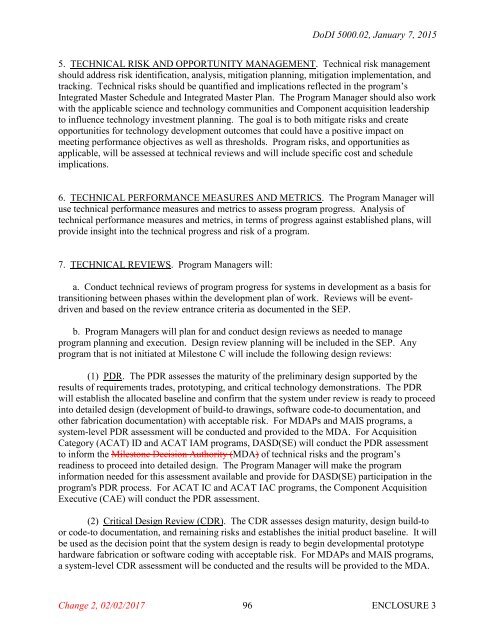Department of Defense INSTRUCTION
x9tnk
x9tnk
Create successful ePaper yourself
Turn your PDF publications into a flip-book with our unique Google optimized e-Paper software.
DoDI 5000.02, January 7, 2015<br />
5. TECHNICAL RISK AND OPPORTUNITY MANAGEMENT. Technical risk management<br />
should address risk identification, analysis, mitigation planning, mitigation implementation, and<br />
tracking. Technical risks should be quantified and implications reflected in the program’s<br />
Integrated Master Schedule and Integrated Master Plan. The Program Manager should also work<br />
with the applicable science and technology communities and Component acquisition leadership<br />
to influence technology investment planning. The goal is to both mitigate risks and create<br />
opportunities for technology development outcomes that could have a positive impact on<br />
meeting performance objectives as well as thresholds. Program risks, and opportunities as<br />
applicable, will be assessed at technical reviews and will include specific cost and schedule<br />
implications.<br />
6. TECHNICAL PERFORMANCE MEASURES AND METRICS. The Program Manager will<br />
use technical performance measures and metrics to assess program progress. Analysis <strong>of</strong><br />
technical performance measures and metrics, in terms <strong>of</strong> progress against established plans, will<br />
provide insight into the technical progress and risk <strong>of</strong> a program.<br />
7. TECHNICAL REVIEWS. Program Managers will:<br />
a. Conduct technical reviews <strong>of</strong> program progress for systems in development as a basis for<br />
transitioning between phases within the development plan <strong>of</strong> work. Reviews will be eventdriven<br />
and based on the review entrance criteria as documented in the SEP.<br />
b. Program Managers will plan for and conduct design reviews as needed to manage<br />
program planning and execution. Design review planning will be included in the SEP. Any<br />
program that is not initiated at Milestone C will include the following design reviews:<br />
(1) PDR. The PDR assesses the maturity <strong>of</strong> the preliminary design supported by the<br />
results <strong>of</strong> requirements trades, prototyping, and critical technology demonstrations. The PDR<br />
will establish the allocated baseline and confirm that the system under review is ready to proceed<br />
into detailed design (development <strong>of</strong> build-to drawings, s<strong>of</strong>tware code-to documentation, and<br />
other fabrication documentation) with acceptable risk. For MDAPs and MAIS programs, a<br />
system-level PDR assessment will be conducted and provided to the MDA. For Acquisition<br />
Category (ACAT) ID and ACAT IAM programs, DASD(SE) will conduct the PDR assessment<br />
to inform the Milestone Decision Authority (MDA) <strong>of</strong> technical risks and the program’s<br />
readiness to proceed into detailed design. The Program Manager will make the program<br />
information needed for this assessment available and provide for DASD(SE) participation in the<br />
program's PDR process. For ACAT IC and ACAT IAC programs, the Component Acquisition<br />
Executive (CAE) will conduct the PDR assessment.<br />
(2) Critical Design Review (CDR). The CDR assesses design maturity, design build-to<br />
or code-to documentation, and remaining risks and establishes the initial product baseline. It will<br />
be used as the decision point that the system design is ready to begin developmental prototype<br />
hardware fabrication or s<strong>of</strong>tware coding with acceptable risk. For MDAPs and MAIS programs,<br />
a system-level CDR assessment will be conducted and the results will be provided to the MDA.<br />
Change 2, 02/02/2017 96<br />
ENCLOSURE 3


